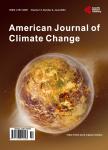Spatial and Temporal Patterns of In Situ Sea Surface Temperatures within the Gulf of Mexico from 1901-2010
Spatial and Temporal Patterns of In Situ Sea Surface Temperatures within the Gulf of Mexico from 1901-2010作者机构:Department of Physics Astronomy & Geosciences Valdosta State University Valdosta GA USA Department of Geography and Anthropology Louisiana State University Baton Rouge LA USA
出 版 物:《American Journal of Climate Change》 (美国气候变化期刊(英文))
年 卷 期:2016年第5卷第3期
页 面:314-343页
主 题:Sea Surface Temperature Gulf of Mexico Temperature Reconstructions Temperature Variability
摘 要:This work examines the spatial and temporal patterns of seasonal sea surface temperatures (SSTs) across the Gulf of Mexico (GoM) for the period 1901-2010. The Extended Reconstructed Sea Surface Temperature, version 4 (ERSST.v4), dataset was selected for this study over other reconstructions because of its 2° × 2° grid cell spatial resolution, its recent update to adjust for known biases in SST observations, and its ability to be compared to other in situ studies of GoM SSTs. The monthly ERSST.v4 data were averaged seasonally for each year and grid cell in the GoM. Seasonal SST trends were then calculated for each grid cell with varying start dates (e.g., 1901-2010, 1911- 2010) to account for nonlinear SST changes over the study period. Results indicate that the GoM SSTs closely resemble those of global annual temperature trends: SSTs warmed from 1901 to ~1940, followed by a period with little trend or a slight cooling until the mid-1970s, and then a warming afterwards through 2010. The spatial patterns and magnitudes of SST changes, however, varied by season and location within the GoM. The spatial patterns involved gradients with latitudinal and/or longitudinal components: a southwest-northeast (warmer-cooler) gradient in winter, an east-west (warmer-cooler) gradient in spring and fall, and a northwest-southeast (warmer-cooler) gradient in summer. The magnitude of SST changes tended to be largest in summer, followed by spring, fall, and winter. The long-term (1901-2010) SST trends were significant throughout the GoM in summer and fall, but only significant towards the southwestern GoM in winter and spring. These results have implications in discussion of climate change and its impacts on tropical activity in the GoM Basin.



